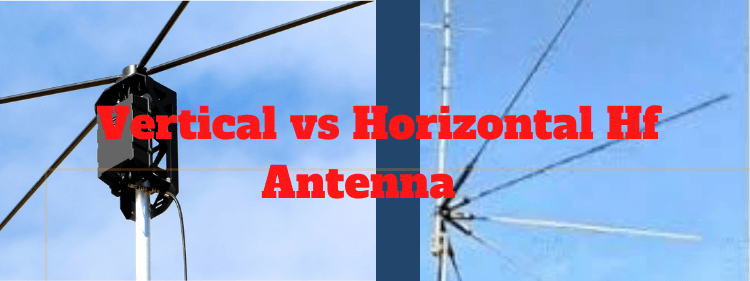Although there is no “correct” answer to the horizontal vs vertical debate, there will be a wide range of responses from amateurs according to their tastes. It’s similar to the Ford vs Chevy debate. However, there’s always the argument that one is better than the other.
Here in this article, you will discuss the topic Vertical vs Horizontal Hf Antenna.

Vertical vs Horizontal Hf Antenna What is Diferents
Vertical Antenna
In essence, a quarter-wave vertical antenna is a half-dipole with radials at or above ground making up the other half of the antenna. HF vertical antennas have the significant advantage of being omnidirectional, which means they can send and receive signals from all directions.

These antennas have a low radiation angle when equipped with good radials. HF radio signals don’t have as many hops to make, making them better for DX, especially on the low bands. As an example, horizontally polarised antennas exhibit identical low-angle performance when placed half a wavelength above ground.
Verticals can be installed in various locations, including on roofs, towers, poles, and even the ground. Ground-mounted models are more discrete, and they’re also easier to maintain. Elevated structures require fewer radials—at least two per band—whereas those below ground require four. Some verticals use a group of short radials with a broadband matching unit instead of conventional length radials if space is an issue. Most of the time, they’re eight to ten feet or higher from the ground.
There are a lot of Ham mobile radios and handheld transceivers on the market that use vertical antennas. They’re popular in part because they’re space-saving and easy to install on automobiles. When it comes to simplex or duplex operation, vertical antennas have traditionally been the go-to choice for portable or mobile use on VHF/UHF frequencies.
Read Also: Top 5 Affordable QRP HF Transceiver
As a result, verticals in AM/CW/SSB have a terrible reputation for picking up more noise than horizontals do. They have a greater sensitivity to vertically polarised sounds, such as thunderclaps or electricity lines running overhead. They’re also more expensive to acquire, and adding radials increases the price even further.
Horizontal Antenna
Simplest and most widely used is the horizontal dipole antenna. They’re inexpensive and straightforward to build, making them popular among radio amateurs at home and on Field Days and other short-term occasions. When utilised at their resonance frequency, dipole antennas are also incredibly efficient.

When transmitting or receiving signals, dipole antennas are almost always omnidirectional. The best places for dipoles are in trees, attics, and along rooflines, so your HOA will be pleased.
Even while horizontal dipoles are simple to construct, they can be challenging to install in trees or on poles and towers because of their size and height. Height is also an important consideration—the better the dipole, the higher it should be. For optimal results and to make DX contacts, a dipole should be placed half a wavelength above the ground. That’s around 13 feet at a distance of 40 meters. Even at half-wavelength heights, many hams claim to be able to get good performance.
When it comes to dipole antennas, you have a lot of options. You can set them up in many different ways, depending on your needs. Trap dipoles, parallel dipoles, and off-center-fed (OCF) dipoles are all versions of the dipole that can cover many bands.
The length of a horizontal dipole is one of its drawbacks, particularly at low frequencies. On tiny lots, the dipole antenna is impractical due to its half-wave characteristic. The length would be 130 feet for the 80-meter band and 260 feet for the 160-meter band.
Read Also: Top 5 Cheap HF Transceivers Review
What Is the Solution?
The horizontal dipole is an excellent choice if the price is your primary concern. To make this simple antenna, all you’ll need is wire, insulators, and a length of rope for support. Make sure you have two places to hang the dipole, like trees or poles. Keep in mind that getting higher is always preferable. With only one support, you can make an inverted-V structure by drooping the ends. Your inverted-ends V’s should be at least eight feet above ground to ensure that people and pets aren’t at risk from them.
The vertical should be taken into account by DXers. They don’t take up a lot of room, are usually not more than 30 feet tall, and only need a few guy lines for support. Because vertical antennas have a lower radiation angle, you’ll have a better chance of making contacts all over the world. The disadvantage is that they can be expensive (up to several hundred dollars), time-consuming (to assemble), and necessitate the use of radials.
If you’re still undecided, why not combine the two? Until I had both vertical and horizontal HF band antenna options, I didn’t consider my antenna farm complete. As a result, I combined the best of both worlds onto a 0.3-acre suburban property.
Antennas with vertically and horizontally polarised radiation patterns work well together. If one fails, the other may succeed. Things that the dipole can’t get to with the vertical and vice versa may surprise you. It’s an excellent strategy for increasing contacts when used in conjunction with propagation changes.
Conclusion
There is a lot of debate about Vertical vs Horizontal Hf Antenna. But, it’s better to go with the horizontal antenna over the vertical one if you just have room for one antenna. When placed close to the ground, wide-band active tiny magnetic receiving loops (not to be confused with tuned magnetic loops) provide better noise immunity during reception than conventional antennas.
